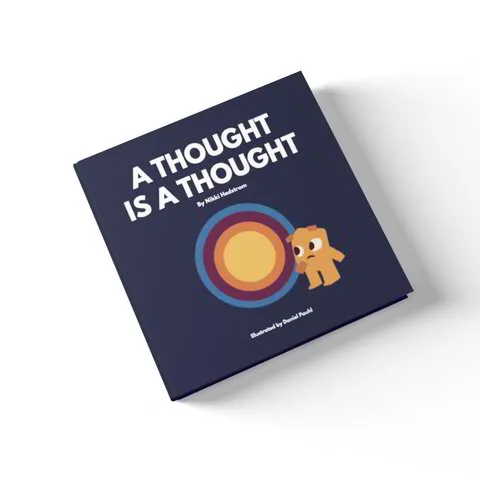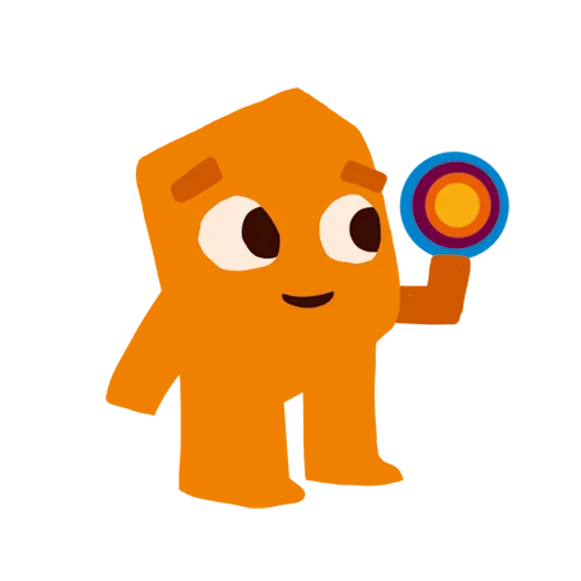Explaining Thoughts:
Activities & Worksheets
FOR HEALTHY YOUNG MINDS
What is a Thought?
What is a Thought?
“You don’t choose your thoughts: you only choose what you do with your thoughts.” Let's learn about what is a thought?
Cognitive Behavioural Therapy
Cognitive Behavioural Therapy
Learn how thoughts impact emotions and actions.
Thought-Emotion-Action Worksheet
Thought-Emotion-Action Worksheet
Learn how to demonstrate the "Thought-Emotion-Action" feedback loop and teach your anxious child how to interrupt negative thoughts.
Core Beliefs
Core Beliefs
Core beliefs are basic beliefs about ourselves, other people, and the world we live in. They are things we hold to be absolute truths deep down, underneath all our “surface” thoughts.
Positive Thoughts
Positive Thoughts
We have thoughts all day every day, and unfortunately, many of them are negative. When it comes to shifting our mindset, it’s important to replace negative thoughts with positive thoughts. One quick way to help train your brain to think more positivity is to have a daily practice of repeating positive affirmations. This is especially important for children that suffer from anxiety as their brains often are scanning for threats and need more support identifying the good.
Positive Affirmation Worksheet
Positive Affirmation Worksheet
Help your child train their brain for positive thoughts by having a daily affirmation practice.
The Ego
The Ego
Explaining Thoughts to An Anxious Child: Anxiety & The Ego.
Explaining Thoughts to Kids
Understanding the concept of thoughts is a challenge, even for adults. To help kids understand the fundamentals about thoughts and how they impact our emotions start with picking up this book.
Includes:
Thought exercises
Emotions chart
Positive affirmations
Breathing exercise
Explaining Thoughts to Kids
Understanding the concept of thoughts is a challenge, even for adults. To help kids understand the fundamentals about thoughts and how they impact our emotions start with picking up this book.
Includes:
Thought exercises
Emotions chart
Positive affirmations
Breathing exercise
What is a Thought?
“You don’t choose your thoughts: you only choose what you do with your thoughts.”
Definition: Thought
noun
1) an idea or opinion produced by thinking, or occurring suddenly in the mind.
2) the action or process of thinking.
Well, there you have it. The dictionary definition. But we all know thoughts are a lot more complex than that. In fact, the average person has over 20,000 thoughts a day.
What is important to note is that thoughts are as natural to our physical functioning as breathing. There is no way to stop our thoughts but there are tools to help reduce negative thoughts and replace them with more positive ones. If you are on this site, you likely have a little one in your life that is having issues with anxious thoughts.
I wrote the book “A Thought is a Thought” to help parents and caregivers open the conversation about thoughts. It has helpful tips and a refrain that can be used within your home to call on when you’re having a negative, nagging thought. However, there are so many things you can do to help better understand thoughts. I’ll start by breaking down how our thoughts impact our feelings and behaviours by outlining the basics of Cognitive Behavioural Therapy.
What is a Thought?
“You don’t choose your thoughts: you only choose what you do with your thoughts.”
Definition: Thought
noun
1) an idea or opinion produced by thinking, or occurring suddenly in the mind.
2) the action or process of thinking.
Well, there you have it. The dictionary definition. But we all know thoughts are a lot more complex than that. In fact, the average person has over 20,000 thoughts a day.
What is important to note is that thoughts are as natural to our physical functioning as breathing. There is no way to stop our thoughts but there are tools to help reduce negative thoughts and replace them with more positive ones. If you are on this site, you likely have a little one in your life that is having issues with anxious thoughts.
I wrote the book “A Thought is a Thought” to help parents and caregivers open the conversation about thoughts. It has helpful tips and a refrain that can be used within your home to call on when you’re having a negative, nagging thought. However, there are so many things you can do to help better understand thoughts. I’ll start by breaking down how our thoughts impact our feelings and behaviours by outlining the basics of Cognitive Behavioural Therapy.
What is CBT?
Cognitive-behavioural therapy (CBT) is a practical, short-term form of psychotherapy. It helps people develop skills and strategies for becoming and staying healthy.
CBT focuses on the here-and-now—on the problems that come up in day-to-day life. CBT helps people to examine how they make sense of what is happening around them and how these perceptions affect the way they feel.
Depending on the severity of your child’s anxiety, it could be helpful to have them see a therapist that specializes in CBT. To give you an example of how CBT works, let me walk you through a scenario.
Let's Put it in Action:
Let’s say your child comes home from school and is upset because they waved at their friend and their friend didn’t wave back. As you ask them to explain what happened they say “I waved a Tom and he didn’t wave back. He must not like me anymore. I don’t know what I did wrong.” You observe that your child is both hurt, but also mad because they feel like they have been wronged.
What’s critical in this situation is to interrupt the negative thought “He must not like me anymore,” and challenge it to see if there is any other plausible scenario that might account for their friend not waving back. It’s important to work with your child to understand what else might have happened. It’s ok to offer some alternatives, but it’s more powerful when the child is able to come up with the scenarios on their own. For example, another way of looking at the same situation is that Tom didn’t see your child. It wasn’t malicious and the friendship is still intact. The emotions that go along with that feeling might be something more in line with “confused”.
Scenario 1 vs 2
Scenario 1 - Trigger - Friend didn’t wave —> Thought - Friend doesn’t like me —> Emotion - Hurt —> Action - Ignores Tom at school the next day
Scenario 2 - Trigger - Friend didn’t wave —> Thought - I guess Tom didn’t see me —> Emotion - Confused / Surprised —> Action - Tells Tom he waved at him but he didn’t wave back
What’s important is that they are able to identify that there is another thought that they can have. The goal is to show them that there are at least one to two different thoughts they can have about the situation. Once you’ve got your child to list off a couple more ideas, evaluate if they know that the first negative thought they had was true. Likely, having two more options on the table means that they can’t know for certain that their first thought was right. This allows them to be open to choosing another thought. The idea is to shift their mind from the first negative thought to another neutral or positive thought.
Not all scenarios need to be turned into positive ones, but the goal is to shift to a more neutral thought vs a negative thought.
Once you get familiar with this concept, remind your child that “A thought is just a thought.” When we empower our kids to understand that they can let thoughts go, think of a helium balloon floating up into the sky, getting smaller and smaller. We don’t need to let the thought stick around, especially if it’s a negative one.
Another way to think about it is to leverage their creative thinking. Make it playful, challenge them to be creative in thinking about why someone might have acted the way they did. As we all know, we rarely know why people behave the way they do, so learning to not take things personally, and finding a thought that is neutral or positive can greatly improve our mental health.
Quick Tip from Child Mind Institute:
Don’t ask leading questions
“Encourage your child to talk about his feelings, but try not to ask leading questions— “Are you anxious about the big test? Are you worried about the science fair?” To avoid feeding the cycle of anxiety, just ask open-ended questions: “How are you feeling about the science fair?”” Clark Goldstein, PhD
For a handy worksheet that outlines this process download the CTB Worksheet.
What is CBT?
Cognitive-behavioural therapy (CBT) is a practical, short-term form of psychotherapy. It helps people develop skills and strategies for becoming and staying healthy.
CBT focuses on the here-and-now—on the problems that come up in day-to-day life. CBT helps people to examine how they make sense of what is happening around them and how these perceptions affect the way they feel.
Depending on the severity of your child’s anxiety, it could be helpful to have them see a therapist that specializes in CBT. To give you an example of how CBT works, let me walk you through a scenario.
Let's Put it in Action:
Let’s say your child comes home from school and is upset because they waved at their friend and their friend didn’t wave back. As you ask them to explain what happened they say “I waved a Tom and he didn’t wave back. He must not like me anymore. I don’t know what I did wrong.” You observe that your child is both hurt, but also mad because they feel like they have been wronged.
What’s critical in this situation is to interrupt the negative thought “He must not like me anymore,” and challenge it to see if there is any other plausible scenario that might account for their friend not waving back. It’s important to work with your child to understand what else might have happened. It’s ok to offer some alternatives, but it’s more powerful when the child is able to come up with the scenarios on their own. For example, another way of looking at the same situation is that Tom didn’t see your child. It wasn’t malicious and the friendship is still intact. The emotions that go along with that feeling might be something more in line with “confused”.
Scenario 1 vs 2
Scenario 1 - Trigger - Friend didn’t wave —> Thought - Friend doesn’t like me —> Emotion - Hurt —> Action - Ignores Tom at school the next day
Scenario 2 - Trigger - Friend didn’t wave —> Thought - I guess Tom didn’t see me —> Emotion - Confused / Surprised —> Action - Tells Tom he waved at him but he didn’t wave back
What’s important is that they are able to identify that there is another thought that they can have. The goal is to show them that there are at least one to two different thoughts they can have about the situation. Once you’ve got your child to list off a couple more ideas, evaluate if they know that the first negative thought they had was true. Likely, having two more options on the table means that they can’t know for certain that their first thought was right. This allows them to be open to choosing another thought. The idea is to shift their mind from the first negative thought to another neutral or positive thought.
Not all scenarios need to be turned into positive ones, but the goal is to shift to a more neutral thought vs a negative thought.
Once you get familiar with this concept, remind your child that “A thought is just a thought.” When we empower our kids to understand that they can let thoughts go, think of a helium balloon floating up into the sky, getting smaller and smaller. We don’t need to let the thought stick around, especially if it’s a negative one.
Another way to think about it is to leverage their creative thinking. Make it playful, challenge them to be creative in thinking about why someone might have acted the way they did. As we all know, we rarely know why people behave the way they do, so learning to not take things personally, and finding a thought that is neutral or positive can greatly improve our mental health.
Quick Tip from Child Mind Institute:
Don’t ask leading questions
“Encourage your child to talk about his feelings, but try not to ask leading questions— “Are you anxious about the big test? Are you worried about the science fair?” To avoid feeding the cycle of anxiety, just ask open-ended questions: “How are you feeling about the science fair?”” Clark Goldstein, PhD
For a handy worksheet that outlines this process download the CTB Worksheet.
Thought-Emotion-Action Worksheet
A demonstration of how thoughts impact emotions that lead to our actions.
Learn how to demonstrate the "Thought-Emotion-Action" feedback loop and teach your anxious child how to interrupt negative thoughts.
Thought-Emotion-Action Worksheet
A demonstration of how thoughts impact emotions that lead to our actions.
Learn how to demonstrate the "Thought-Emotion-Action" feedback loop and teach your anxious child how to interrupt negative thoughts.
What is a Core Belief?
Core beliefs are basic beliefs about ourselves, other people, and the world we live in. They are things we hold to be absolute truths deep down, underneath all our “surface” thoughts.
It’s important to understand that our core beliefs are established by the age of 8.
The Alpine Stress & Anxiety Clinic outline positive and negative core beliefs as follows:
Positive Core Beliefs:
Self: I am worthy, competent, capable, good enough, lovable, I can trust my decisions.
World: The world is filled with opportunities, everything tends to work out in the end.
Others: People are friendly and helpful. I can count on others, people are basically good.
Negative Core Beliefs:
Self: I’m not good enough, I’m unworthy, my opinions don’t matter, my needs are not important.
World: I can’t trust anyone, no one else really cares, no one will stay forever, I can’t depend on anyone else.
Others: Life is a struggle, you always have to work hard to get what you want, I’m always waiting for the other shoe to drop.
Core Beliefs are like tinted glasses that impact the way we see the world. They create your stories by attaching a meaning, interpreting, judging and evaluating a situation.
- It determines your self talk
- Set up your expectations
Our core beliefs are established in childhood and are impacted by our environment.
Environmental Impacts
Cultural/political climate
- War, political unrest, honour, natural disasters, pandemics
Circumstances around your birth
- Planned, wanted, right sex
Family atmosphere
- Alcoholism, violence, divorce, death
Good/bad parent messages
- “You did a great job!”
- “You never do things right”
It can be helpful to be aware of your core beliefs as a parent, as they impact the way that you interpret the world around you. It can also help you reframe how you position information to your child(ren).
What are the stories you often tell yourself? Are they mostly positive or negative core beliefs? Whatever your temperament is, you are likely to impart on your child(ren). There is always the nature vs nurture argument, but consistently having a positive state of mind puts you in the best position to nurture the same in your child.
Shifting Core Beliefs
If you want to change your core beliefs you can start by asking yourself these questions.
Reflect and own your story and question its validity by asking,
- “Do I absolutely know this to be true?”
Then ask yourself:
- “Who would I be without this story?”,
- “What would I do? How would I react?”
It can be hard not to say things in front of your child that can impact their core beliefs of themselves. Some ways that your core beliefs might be coming out as an adult could be as follows.
Positive Core Belief Parenting
What it might sound like
“I appreciate my body for allowing me to do the things I love.”
“I trust that I made a good choice.”
“I worked hard and hope they see all the positive contributions I’ve made around the office.”
“I think she may have forgotten about our meeting. Something important must have come up. I’ll check in to make sure everything is ok.”
“I appreciate the help.”
“Good things are happening all around us.”
Negative Core Belief Parenting
What it might sound like
“I wish I was as skinny as Rebecca’s mom”
“I'm so fat. I need to lose 20 pounds”
“You can’t trust him. He’s a horrible person.”
“It doesn't matter how hard I work. I always get passed over for promotions.”
“She’s always late! She has no respect for me.”
““The world just keeps getting worse! What next!?”
What is a Core Belief?
Core beliefs are basic beliefs about ourselves, other people, and the world we live in. They are things we hold to be absolute truths deep down, underneath all our “surface” thoughts.
It’s important to understand that our core beliefs are established by the age of 8.
The Alpine Stress & Anxiety Clinic outline positive and negative core beliefs as follows:
Positive Core Beliefs:
Self: I am worthy, competent, capable, good enough, lovable, I can trust my decisions.
World: The world is filled with opportunities, everything tends to work out in the end.
Others: People are friendly and helpful. I can count on others, people are basically good.
Negative Core Beliefs:
Self: I’m not good enough, I’m unworthy, my opinions don’t matter, my needs are not important.
World: I can’t trust anyone, no one else really cares, no one will stay forever, I can’t depend on anyone else.
Others: Life is a struggle, you always have to work hard to get what you want, I’m always waiting for the other shoe to drop.
Core Beliefs are like tinted glasses that impact the way we see the world. They create your stories by attaching a meaning, interpreting, judging and evaluating a situation.
- It determines your self talk
- Set up your expectations
Our core beliefs are established in childhood and are impacted by our environment.
Environmental Impacts
Cultural/political climate
- War, political unrest, honour, natural disasters, pandemics
Circumstances around your birth
- Planned, wanted, right sex
Family atmosphere
- Alcoholism, violence, divorce, death
Good/bad parent messages
- “You did a great job!”
- “You never do things right”
It can be helpful to be aware of your core beliefs as a parent, as they impact the way that you interpret the world around you. It can also help you reframe how you position information to your child(ren).
What are the stories you often tell yourself? Are they mostly positive or negative core beliefs? Whatever your temperament is, you are likely to impart on your child(ren). There is always the nature vs nurture argument, but consistently having a positive state of mind puts you in the best position to nurture the same in your child.
Shifting Core Beliefs
If you want to change your core beliefs you can start by asking yourself these questions.
Reflect and own your story and question its validity by asking,
- “Do I absolutely know this to be true?”
Then ask yourself:
- “Who would I be without this story?”,
- “What would I do? How would I react?”
It can be hard not to say things in front of your child that can impact their core beliefs of themselves. Some ways that your core beliefs might be coming out as an adult could be as follows.
Positive Core Belief Parenting
What it might sound like
“I appreciate my body for allowing me to do the things I love.”
“I trust that I made a good choice.”
“I worked hard and hope they see all the positive contributions I’ve made around the office.”
“I think she may have forgotten about our meeting. Something important must have come up. I’ll check in to make sure everything is ok.”
“I appreciate the help.”
“Good things are happening all around us.”
Negative Core Belief Parenting
What it might sound like
“I wish I was as skinny as Rebecca’s mom”
“I'm so fat. I need to lose 20 pounds”
“You can’t trust him. He’s a horrible person.”
“It doesn't matter how hard I work. I always get passed over for promotions.”
“She’s always late! She has no respect for me.”
““The world just keeps getting worse! What next!?”
Brain Training - How to Encourage Your Anxious Child to Have More Positive Thoughts
We have thoughts all day every day, and unfortunately, many of them are negative. When it comes to shifting our mindset, it’s important to replace negative thoughts with positive thoughts. One quick way to help train your brain to think more positivity is to have a daily practice of repeating positive affirmations. This is especially important for children that suffer from anxiety as their brains often are scanning for threats and need more support identifying the good.
If you are a parent or caretaker of an anxious child, you have the opportunity to help them develop positive self-esteem and build their resiliency by teaching them a daily affirmation practice. It also builds confidence, which is key in reducing stress in worrisome children.
Some simple positive affirmations for kids are:
I am kind
I am smart.
I am brave.
I am funny.
I am strong.
I am helpful.
I am loved.
Take some time each day to repeat these statements out loud with your child. It will help reduce negative self-talk and can make the child feel good about themselves as they embrace their positive qualities. Doing this exercise daily will help retrain and reprogram the brain to have more positive thoughts.
The more we repeat a phrase, the more likely it is to become a hardwired belief. It’s also important to keep the phrase in the present tense. Not “I will be kind” or “I was kind” but “I am kind.” This feeds the brain the message that you are kind. It’s not a future plan or a memory of a kind act, it is who you are.
Developing some positive affirmations with your child, either the ones suggested above, or your own can be an excellent exercise. Remember to keep them short for ease of memory and repetition. You’ll find a resource that outlines some of my favourite positive affirmations here but also a blank worksheet to allow your child to develop their own positive affirmations. Once you’ve decided on your key positive affirmations, it’s recommended you have your child repeat them three times a day. The more consistent they are in repeating the phrases, the more resilient they will be to negative thoughts.
Positive Thought Affirmations for Kids
If you’re looking for a visual daily reminder, you can also print a positive affirmation poster your child can put in their room.
Helpful Tip
Positive thinking is valuable at all ages, so I encourage the whole family to incorporate a positive affirmation practice into their daily routines.
Brain Training - How to Encourage Your Anxious Child to Have More Positive Thoughts
We have thoughts all day every day, and unfortunately, many of them are negative. When it comes to shifting our mindset, it’s important to replace negative thoughts with positive thoughts. One quick way to help train your brain to think more positivity is to have a daily practice of repeating positive affirmations. This is especially important for children that suffer from anxiety as their brains often are scanning for threats and need more support identifying the good.
If you are a parent or caretaker of an anxious child, you have the opportunity to help them develop positive self-esteem and build their resiliency by teaching them a daily affirmation practice. It also builds confidence, which is key in reducing stress in worrisome children.
Some simple positive affirmations for kids are:
I am kind
I am smart.
I am brave.
I am funny.
I am strong.
I am helpful.
I am loved.
Take some time each day to repeat these statements out loud with your child. It will help reduce negative self-talk and can make the child feel good about themselves as they embrace their positive qualities. Doing this exercise daily will help retrain and reprogram the brain to have more positive thoughts.
The more we repeat a phrase, the more likely it is to become a hardwired belief. It’s also important to keep the phrase in the present tense. Not “I will be kind” or “I was kind” but “I am kind.” This feeds the brain the message that you are kind. It’s not a future plan or a memory of a kind act, it is who you are.
Developing some positive affirmations with your child, either the ones suggested above, or your own can be an excellent exercise. Remember to keep them short for ease of memory and repetition. You’ll find a resource that outlines some of my favourite positive affirmations here but also a blank worksheet to allow your child to develop their own positive affirmations. Once you’ve decided on your key positive affirmations, it’s recommended you have your child repeat them three times a day. The more consistent they are in repeating the phrases, the more resilient they will be to negative thoughts.
Positive Thought Affirmation
If you’re looking for a visual daily reminder, you can also print a positive affirmation poster.
Helpful Tip
Positive thinking is valuable at all ages, so I encourage the whole family to incorporate a positive affirmation practice into their daily routines.
Positive Affirmation Worksheet for Kids
Take a moment to celebrate your child's strengths.
Help your child train their brain for positive thoughts by having a daily affirmation practice.
Positive Affirmation Worksheet for Kids
Take a moment to celebrate your child's strengths.
Help your child train their brain for positive thoughts by having a daily affirmation practice.
Explaining Thoughts to An Anxious Child: Anxiety & The Ego
Eckhart Tolle does a brilliant job in his book A New Earth: Awakening Your Life’s Purpose of helping us understand the role of our ego in our suffering. In order to be able to help your child become more mindful, it will be important for you to recognize when you are stepping into ego.
While I’ve done a lot of reading on the ego and being mindful, I still find it helpful to break it down into bite sized pieces. It’s also easier should you decide to introduce this concept to your child to showcase it with these components.
YOU: Your inner essence. Perfect and complete, just as you are.
EGO: The voice in your head that tells you what you are. It is often a complaining voice in your head.
THOUGHTS: An idea that is created by your ego.
OUTSIDE FEEDBACK: How what others say about you impact you.
We all want to have peace and to be happy. Being a happy, peaceful and grounded parent helps you show up in the best way for your child. Start with managing and regulating your own negative thoughts so that you can start to help your anxious child do the same.
Whenever you are moving into drama or distress think about these steps.
Steps:
Detach from the thought you are having.
Acknowledge the thought:
I am having an unpleasant thought
See yourself having the thought
My ego is having a thought about....
Recognize that YOU (the “I” of “I am”) is the awareness that you are having the thought. See the drama the thought is creating and try to detach.
I am not my thoughts. That is just a thought.
Labelling
Our ego likes to label people and to compare ourselves to others. Watch as these thoughts sneak in and dismiss them. You do not need to compare yourself to others to gain self worth.
Complaining
Our ego likes to put us at the centre of things. “Why is this person being so inconsiderate? Why are they late?” Watch for when your ego is sneaking in and taking things personally. Choose a more positive thought instead. It will make you happier in the moment.
Outside Feedback
Not all feedback is helpful. Ask these key questions when deciding if the feedback is actionable.
- Does the person giving me the feedback care about me?
- Is it coming from a place of love?
- Can I learn something and grow from this feedback?
If the answer is no, let that feedback float through you like a fluffy white cloud passes through the sky.
Self Check In
The more in tune you are with your own thoughts, the less attached you’ll be to the endorsement and beliefs of others. Try to interrupt the need for external validation. When you feel the need for external validation, take some deep breaths and do a body scan to see if you can find that validation internally.
Ego & its Relationship to Being a Parent
It can be hard as a parent to untangle your self worth from the self worth of your child. Be mindful of the pressures you put on your child, especially children that suffer from perfectionism. While it’s unintentional to base your self worth as contingent on their behaviour, it can be damaging for both you as the parent and for the child. One of the greatest gifts you can give your child is the autonomy of personal expression, by letting them be themselves. As adults we carry a train load of baggage about the things we wish we had done differently or experiences of pain we wish we could have avoided. To feel and experience pain is to be human. We need to be mindful to limit our judgements of our children’s experiences by removing our internal biases and experiences. What was traumatic for us, may be a breeze for our children.
Quick Breakdown
I am not my thoughts. That is just a thought.
Mantra: A Thought is a thought. It's not me, it's just not.
Helpful Tip
When you are having a negative thought, recognize it as just a thought.
Resources & Additional Reading
Explaining Thoughts to An Anxious Child: Anxiety & The Ego
Eckhart Tolle does a brilliant job in his book A New Earth: Awakening Your Life’s Purpose of helping us understand the role of our ego in our suffering. In order to be able to help your child become more mindful, it will be important for you to recognize when you are stepping into ego.
While I’ve done a lot of reading on the ego and being mindful, I still find it helpful to break it down into bite sized pieces. It’s also easier should you decide to introduce this concept to your child to showcase it with these components.
YOU: Your inner essence. Perfect and complete, just as you are.
EGO: The voice in your head that tells you what you are. It is often a complaining voice in your head.
THOUGHTS: An idea that is created by your ego.
OUTSIDE FEEDBACK: How what others say about you impact you.
We all want to have peace and to be happy. Being a happy, peaceful and grounded parent helps you show up in the best way for your child. Start with managing and regulating your own negative thoughts so that you can start to help your anxious child do the same.
Whenever you are moving into drama or distress think about these steps.
Steps:
Detach from the thought you are having.
Acknowledge the thought:
I am having an unpleasant thought
See yourself having the thought
My ego is having a thought about....
Recognize that YOU (the “I” of “I am”) is the awareness that you are having the thought. See the drama the thought is creating and try to detach.
I am not my thoughts. That is just a thought.
Labelling
Our ego likes to label people and to compare ourselves to others. Watch as these thoughts sneak in and dismiss them. You do not need to compare yourself to others to gain self worth.
Complaining
Our ego likes to put us at the centre of things. “Why is this person being so inconsiderate? Why are they late?” Watch for when your ego is sneaking in and taking things personally. Choose a more positive thought instead. It will make you happier in the moment.
Outside Feedback
Not all feedback is helpful. Ask these key questions when deciding if the feedback is actionable.
- Does the person giving me the feedback care about me?
- Is it coming from a place of love?
- Can I learn something and grow from this feedback?
If the answer is no, let that feedback float through you like a fluffy white cloud passes through the sky.
Self Check In
The more in tune you are with your own thoughts, the less attached you’ll be to the endorsement and beliefs of others. Try to interrupt the need for external validation. When you feel the need for external validation, take some deep breaths and do a body scan to see if you can find that validation internally.
Ego & its Relationship to Being a Parent
It can be hard as a parent to untangle your self worth from the self worth of your child. Be mindful of the pressures you put on your child, especially children that suffer from perfectionism. While it’s unintentional to base your self worth as contingent on their behaviour, it can be damaging for both you as the parent and for the child. One of the greatest gifts you can give your child is the autonomy of personal expression, by letting them be themselves. As adults we carry a train load of baggage about the things we wish we had done differently or experiences of pain we wish we could have avoided. To feel and experience pain is to be human. We need to be mindful to limit our judgements of our children’s experiences by removing our internal biases and experiences. What was traumatic for us, may be a breeze for our children.
Quick Breakdown
I am not my thoughts. That is just a thought.
Mantra: A Thought is a thought. It's not me, it's just not.
Helpful Tip
When you are having a negative thought, recognize it as just a thought.
Resources & Additional Reading
Is your child experiencing anxiety? 'A Thought Is A Thought" explains what a thought is, how to navigate negative thoughts and includes the framework of cognitive behavioural therapy to help families talk about big feelings.
It includes:
- A thought exercise to challenge negative thoughts
- Positive affirmations to promote positive thinking
- A breathing exercise for kids
- A emotions chart to help kids identify their feelings











